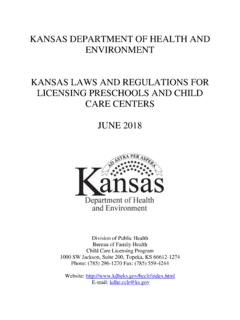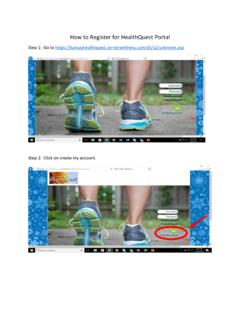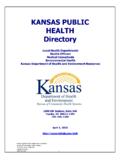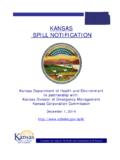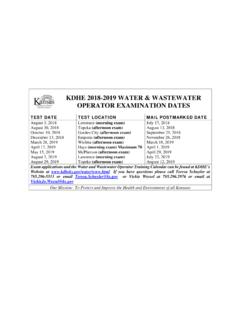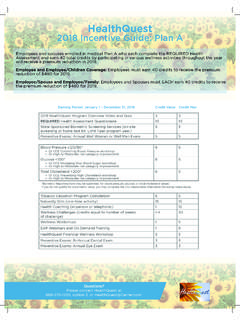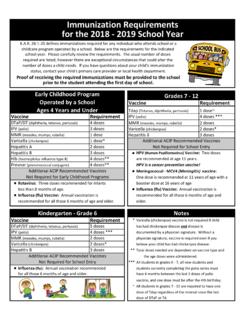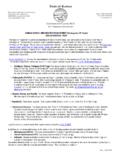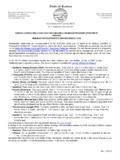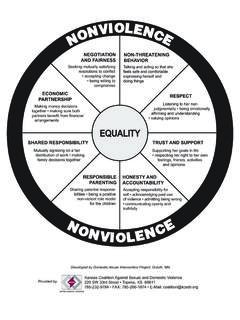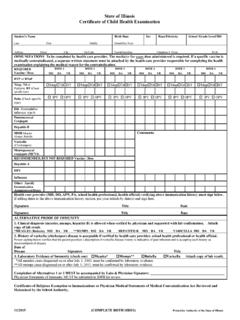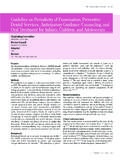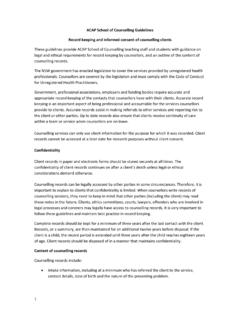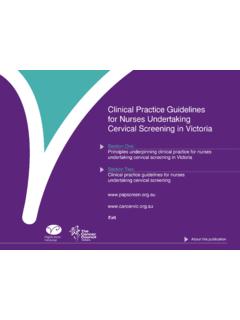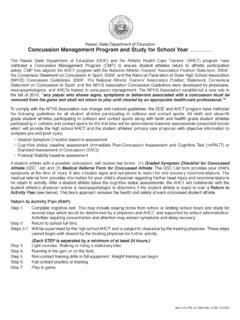Transcription of VISION SCREENING GUIDELINES: For Infants, Toddlers ...
1 VISION SCREENING guidelines : For Infants, Toddlers , Children and Youth June 2004 Fifth Edition Kansas Department of health and Environment Bureau for Children, Youth and Families 1000 SW Jackson, Suite 220 Topeka, Kansas 66612-1274 785-291-3368 or 800-332-6262 Core Coordinating Committee: Jamey Kendall, RN, BSN, Director, Services for Children with Special health Care Needs, KS Department of health & Environment (KDHE) Ileen Meyer, RN, MS, Director, Children & Families, KDHE Carolyn Nelson, BSE, Director, Children s Development Services, KDHE Jane Stueve, RN, BSN, Newborn Metabolic SCREENING Consultant, KDHE Theresa Tetuan, RN, PhD, Adolescent health Consultant, School health Consultant, KDHE Christine Tuck, RN, MS, Child health Consultant, School health Consultant, KDHE Reviewers for 2004 Revisions.
2 Mae Claxton, RN, health Services Supervisor, Kansas State School for the Blind; KS School Nurse Organization Jeff A. Cook, Psy. S., Project Director, The Kansas Project for Children and Young Adults Who Are Deaf-Blind, Kansas State Department of Education (KSDE) Pam Cress, Ed. S., KU Bureau of Child Research Life Span Institute, Parsons, KS Kansas Medical Society, Jerry Slaughter, Executive Director: reviewed by Allan M. Eisenbaum, MD; David A. Johnson, MD, PhD. Kansas Optometric Association: reviewed by Stacy Clark, OD; Wayne Hemphill, OD; Patrick Pirotte, OD; and Joseph Sullivan, OD.
3 Shirley Orr, RN, Director of Local health , Office of Local and Rural health , KDHE iVISION SCREENING guidelines TABLE OF CONTENTS Introduction ..1 Background ..3 Kansas VISION SCREENING Qualifications of VISION Screener ..7 Parent/Guardian Refusal for Referral and Follow-up ..8 KAN Be Healthy (EPSDT) VISION SCREENING guidelines ..9 Collaboration of Systems ..9 VISION SCREENING for Infants and Young SCREENING of Children and Youth with Disabilities ..12 VISION SCREENING Matrix ..13 General Preparations for SCREENING Infants and Toddlers ..14 Eye Lid Fixation ..16 Risk Risk Factors -- Checklist.
4 18 Pupil Response ..20 Teller Acuity Cards ..21 Photo Refractor/PhotoScreenerTM ..22 Corneal Light Reflection -- ii Diagram of Hirschberg Test ..24 ABC's of VISION ..25 ABC's of VISION Cover-Uncover Test ..27 Near Point of Convergence ..28 Worth 4-Dot Depth Perception --Titmus Fly ..30 Random Dot General Considerations for Acuity Distance Acuity -- Letter or E Charts ..36 HOTV Color VISION ..39 Plus Lens for ..40 Near Acuity ..41 Stereoscopic ..42 Usher Syndrome SCREENING ..43 APPENDIX Summary of Referral Reference Report of VISION SCREENING for ..52 VISION SCREENING .
5 53 Parent Notification Regarding Color VISION ..54 Sample Letter -- Feedback on VISION ..55 Anatomy of the ..56 Refractive Error Descriptions and Diagrams: ..59 iii This page was intentionally left blank INTRODUCTION The philosophy for preventive health services is to identify health problems or potential health problems at the earliest possible time, to promote early intervention for those problems, and to promote optimum health in children and youth. Where eye health is concerned, each child should have a complete VISION SCREENING prior to age 3 in order to detect potential acuity or otor problems and facilitate effective early treatment through referral and follow-up.
6 Oculom In addition to detecting potential VISION problems, VISION SCREENING programs are valuable in raising the awareness of parents, teachers, early interventionists, day care providers and the community to the importance of eye care. Another SCREENING benefit is the identification of children who may need special education services because of a visual impairment. The final but most important aspect of the SCREENING program is follow-up. The child who does not pass the VISION SCREENING should receive a professional eye examination. If the children referred do not receive professional attention, the VISION SCREENING program has not accomplished its mission.
7 According to the American Optometric Association, a child s first professional eye examination should be scheduled at 6 months of age (or sooner if signs or symptoms warrant). When no abnormalities are detected at this age, the next examination should be scheduled at age The goals of the Kansas VISION SCREENING program are parallel with the philosophy of early identification and intervention. The goals are: Ensure the inclusion of VISION SCREENING in all health assessments for children and youth (birth to 21 years). Promote remediation of identified VISION problems at the earliest possible time.
8 Objectives of the Kansas VISION SCREENING program are to: Utilize uniform SCREENING guidelines and referral criteria throughout the state. Collaborate on an interagency basis for intervention of identified problems. Follow-up on all referrals where evaluation and/or treatment is recommended. Maintain VISION records on children and youth and document VISION SCREENING activities. These guidelines should be utilized for all age children and youth (birth to 21 years) in child health programs including EPSDT (KAN Be Healthy) SCREENING , well child SCREENING , Part C early intervention SCREENING , and school SCREENING .
9 They are designed to be used in conjunction with child health standards of care. 1 American Optometric Association, Clinical Practice guidelines , Pediatric Eye and VISION Examinations, 2nd Edition, April 2002 - 1 - All VISION screeners in child health programs should meet the same standard. The VISION SCREENING workshops will focus on skills required for all VISION screeners who screen children and youth birth through age 21. Screeners should review the VISION SCREENING guidelines periodically to maintain basic proficiency levels.
10 It is each screener s responsibility to attend a workshop when the screener decides it is necessary to be retrained in basic skills. Exception: Screeners providing VISION SCREENING for Part C Infant-Toddler Services, shall retrain in basic skills every three years. When following these guidelines , it is understood that: 1. Protocols and pass/fail criteria, as described in the published test by the commercial company, take precedence over directions and pass/fail criteria in the guidelines . 2. Except in unusual circumstances, or when there is an obvious problem needing immediate attention, the VISION screener should rescreen failed tests before making a referral.
